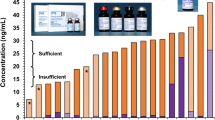Abstract
Quality assurance and method validation are needed to reduce false decisions due to measurement errors. In this context accuracy and standard uncertainty for the analytical method need to be considered to ensure that the performance characteristics of the method are understood. Therefore, analytical methods ought to be validated before implementation and controlled on a regular basis during usage. For this purpose reference materials (RMs) are useful to determine the performance characteristics of methods under development. These performance parameters may be documented in the light of a method evaluation study and the documentation related to international standards and guidelines. In a method evaluation study of Pb in blood using reference samples from the Laboratoire Toxicologie du Quèbec, Canada, a difference between the systematic errors was observed using a Perkin-Elmer Model 5100 atomic absorption spectrometer and a Perkin-Elmer Model 4100 atomic absorption spectrometer, both with Zeeman background correction. For measurement of blood samples, the performance parameters obtained in the method evaluation studies, i.e. slopes and intercepts of the method evaluation function (MEF), were intended to be used for correcting the systematic errors. However, the number of MEF samples was insufficient to produce an acceptable SD for the MEF slopes to be used for correction. In a method evaluation study on valproate in plasma using the SYVA's EMIT assay on COBAS MIRA S a significant systematic error above the concentration 300 mmol dm−3 was demonstrated (slope 0.9541) and consequently the slope was used for correction of results. For analytes, where certified RMs (CRMs) exist, a systematic error of measurements can be reduced by correcting errors by assessment of the trueness as recommended in international guidelines issued by ISO or the National Institute of Standards and Technology (NIST). When possible, the analysis of several RMs, covering the concentration range of interest, is the most useful way to investigate measurement bias. Unfortunately, until recently only few RMs existed and only few had been produced and certified by specialized organizations such as NIST or the Standards, Measurements and Testing (SMT, previously BCR) programme. Due to the lack of such RMs, network organizations are nowadays established with the aim of supporting the correct use and production of high-quality CRMs.
Similar content being viewed by others
References
A. R. Flegal, D. R. Smith,Environ. Res. 1992,58, 125.
D. Becker, R. Christensen, L. Currie, B. Diamondstone, K. Eberhardt, T. Gills, H. Hertz, G. Klouda, J. Moody, R. Parris, R. Schaffer, E. Steel, J. Taylor, R. Watters, R. Zeisler,NIST Special Publication 829, National Institute of Standards and Technology, 1992.
WELAC/EURACHEM,Accreditation for Chemical Laboratories: Guidance on Interpretation of the EN 45000 Series of Standards and ISO/IEC Guide 25, Guidance document WGD2/No. 1, 1993.
ISO/REMCON 319,Traceability and Calibration in Analytical Chemistry and Material Testing: Principles and Applications to Real Life, in Connection with ISO 9000, EN 45000 and ISO Guide 25, June 1994.
L. Aarons, S. Toon, M. Rowland,J. Pharm. Meth. 1987,17, 337.
J. M. Christensen, O. M. Poulsen, T. Anglov,J. Anal. At. Spectrom. 1992,7, 329.
J. M. Christensen, O. M. Poulsen, T. Anglov, in:Handbook on Metals in Clinical and Analytical Chemistry, 1st Ed. (H. G. Seiler, A. Sigel, H. Sigel, eds.) Marcel Dekker, New York, 1994, p. 45.
ISO 8402,Quality Management and Quality Assurance Vocabulary, Geneva, ISO 1994.
ISO,Guide to the Expression of Uncertainty in Measurement, 1st Ed., International Organization for Standardization (ISO), International Electrotechnical Commission (IEC), International Organization of Legal Metrology (OIML), International Bureau of Weights and Measures (BIPM), 1993.
R. Cornelis,Mikrochim. Acta 1991,III, 37.
WELAC,The Expression of Uncertainty in Testing, Draft Document WG 5, 1994.
EURACHEM,Quantifying Uncertainty in Analytical Measurements, Draft Version 5, Eurachem, September 1994.
EN 45001,General Criteria for the Operation of Testing Laboratories, Bruxelles, CEN, 1991.
WECC Doc. 19-1990,Guidelines for the Expression of the Uncertainty of Measurement in Calibrations, Western European Calibration Cooperation (WECC), 1990.
W. Horwitz,Pure Appl. Chem. 1990,62, 1193.
W. Horwitz,Pure Appl. Chem. 1988,60, 855.
Å. M. Hansen, I. L. B. Olsen, E. Holst, O. M. Poulsen,Ann. Occup. Hyg. 1991,35, 603.
A. J. L. Mürer, A. Abildtrup, O. M. Poulsen, J. M. Christensen,Talanta 1992,39, 469.
I. B. O. Olsen, E. Holst,Analyst 1992,117, 707.
A. J. L. Mürer, J. M. Christensen, T. Midtgaard,Int. Arch. Occup. Environ. Health 1994,65, 313.
ISO/REMCO N 263,Calibration of Chemical Analyses and Use of Certified Reference Materials, Draft Version, November 1994.
ISO/REMCO N 278,Traceability of the Property Values of Certified Reference Materials, Draft Version March 1994.
K. S. Subramanian, J. C. Meranger,Clin. Chem. 1981,27, 1866.
S. Waarst,Report on EMIT Assay for the Determination of Valproat in Plasma, Personal Communication, 1994.
K. Heydorn,Mikrochim. Acta 1991,III, 1.
J. K. Taylor,Fresenius Z. Anal. Chem. 1988,332, 722.
J. C. Miller, J. N. Miller,Statistics for Analytical Chemistry, 3rd Ed., Ellis Horwood, Chichester, 1993.
P. Armitage, G. Berry,Statistical Methods in Medical Research, 2nd Ed., Blackwell, Oxford, 1971. p. 266.
S. L. Christensen, J. T. B. Anglov, J. M. Christensen, E. Olsen, O. M. Poulsen,Fresenius J. Anal. Chem. 1993,345, 343.
J. Kristiansen, J. M. Christensen, J. L. Nielsen,Mikrochim. Acta 1995,123, 241.
J. M. Christensen,Sci. Tot. Environ. 1995,166, 89.
S. D. Rasberry, T. E. Gills,Spectrochim. Acta 1991,46, 1577.
ISO Guide 30,Terms and Definitions Used in Connection with Reference Materials, Geneva, ISO 1992.
ISO/DIS 5725General Principles and Definitions, Part 1, Draft 1991.
ISO/IEC, Guide 25,General Requirements for the Competence of Calibration and Testing Laboratories, 3rd Ed., Geneva, ISO, 1990.
ISO/IEC,Guide 49, Guidelines for Development of a Quality Manual for a Testing Laboratory, Geneva, ISO, 1986.
J. Kristiansen, J. M. Christensen, J. Merry, M. Tambo, S. A. Linde, B. Nyeland,Fresenius J. Anal. Chem. 1995,352, 157.
Author information
Authors and Affiliations
Rights and permissions
About this article
Cite this article
Molin Christensen, J. Correcting measurement errors using reference materials in method validation. Mikrochim Acta 123, 231–240 (1996). https://doi.org/10.1007/BF01244396
Issue Date:
DOI: https://doi.org/10.1007/BF01244396




